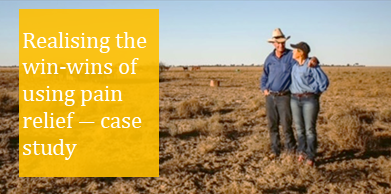Pain relief options for animal husbandry procedures
Pain and discomfort is associated with some animal husbandry procedures such as branding, ear marking, castration, dehorning, disbudding and spaying.
Availability and access to registered pain-relief options for livestock have recently improved. Each pain relief option has a different purpose. It is important producers understand the most suitable pain-relief option(s) for certain procedures.
The tables below (Table 1.1 and Table 1.2 sourced from Cattle Council) outline the level of pain and discomfort that may be experienced during certain procedures. The table also outlines the most suitable pain-relief option(s) for the specific procedures.

Types of pain relief
Regarding types of pain and what pain relief to use, there are two types of pain: Immediate and inflammatory.
Immediate pain that is initial, sharp and occurs immediately follows a procedure such as dehorning or castration. This pain can be high but typically only lasts about 8 hours. To reduce this pain, a local anaesthetic such Tri-solfen® should be administered.
Inflammatory and longer-term pain is experienced following the initial pain. This type of pain is persistent minor pain which causes discomfort that can cause livestock to sulk and prevent them from grazing or calves from nursing. The duration that this pain lasts for is linked to how high the initial immediate pain was. So, to reduce this pain you use long-acting nonsteroidal anti-inflammatory drugs (NSAIDs) such as Buccalgesic® or Metacam®.
Pain relief programs
 Ideally, you would combine both a topical local anaesthetic to cover the initial sharp pain and NSAID’s to reduce pain in discomfort in the following days. The better the physiological pain is controlled, the better the recovery overall – but at the end of the day, if a producer doesn’t have access to both types of pain relief, one is still better than nothing. For procedures such as spaying and branding, topical products like Tri-solfen® will not be effective as they are only a local anaesthetic which directly target local nerve endings. In this situation a meloxicam type product (Buccalgesic®, Metacam®) would as these produces will provide systemic pain relief.
Ideally, you would combine both a topical local anaesthetic to cover the initial sharp pain and NSAID’s to reduce pain in discomfort in the following days. The better the physiological pain is controlled, the better the recovery overall – but at the end of the day, if a producer doesn’t have access to both types of pain relief, one is still better than nothing. For procedures such as spaying and branding, topical products like Tri-solfen® will not be effective as they are only a local anaesthetic which directly target local nerve endings. In this situation a meloxicam type product (Buccalgesic®, Metacam®) would as these produces will provide systemic pain relief.
Table 2 shows a summary of the available pain-relief options. This table shows the withholding periods (WHPs), Export slaughter intervals (ESI), cost per application based on a 160-200 kg weaner using recommended dosages and the specifics of each of the pain relief options.

The benefits of pain relief for these essential procedures are widely acknowledged and supported by field trials. Aside from the welfare benefits, production is enhanced as animals suffer less pain, and as a result return to normal feeding and other activities in a much faster time than without any pain relief. Other benefits are less stress (physiologically measured with cortisol levels – this linking back into improved weight gains) and handling should prove easier.
Pain relief trial
The Northern Territory Department of Industry, Tourism and Trade, in collaboration with Queensland Department of Agriculture and Fisheries, and the Western Australian Department of Primary Industries and Regional Development are trialling the use of pain relief on commercial properties across northern Australia. This project will evaluate the effectiveness and long-term production benefits associated with providing pain relief around the time of castration and dehorning in young cattle.
 The objective of this trial is to evaluate the effectiveness of providing pain relief during the standard husbandry practices of castration and dehorning for providing welfare and production benefits.
The objective of this trial is to evaluate the effectiveness of providing pain relief during the standard husbandry practices of castration and dehorning for providing welfare and production benefits.
The pilot trial study effectively integrated Tri-solfen® and Meloxicam into regular husbandry procedures. Welfare benefits and production effects were observed during this trial, with positive results.
The trial will be continued on a larger scale with several properties to supply between 300-600 calves to be castrated and/or dehorned. The study is designed to coincide with normal mustering and calf marking times for properties. Prior to castration/dehorning, calves will be weighed and tagged with either an NLIS tag or management tag so individual animal’s weight change can be monitored. Calves will be randomly allocated to one of four treatment groups: Control (no pain relief), Tri-solfen® only, Meloxicam only, Tri-solfen® and Meloxicam.
More information
If you are interested in finding out more about the different pain relief options and their applications, please contact your local beef extension officer or veterinarian, or visit: Pain relief medication for beef cattle.
Beef producer case study:
Realising the win-wins of pain relief with Sue and Herb George of ‘Glen Valley’, near Jundah
